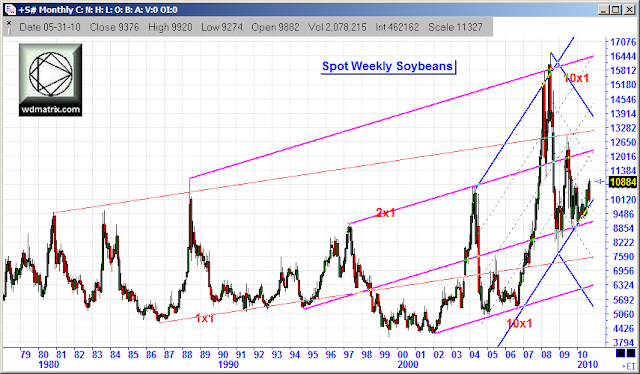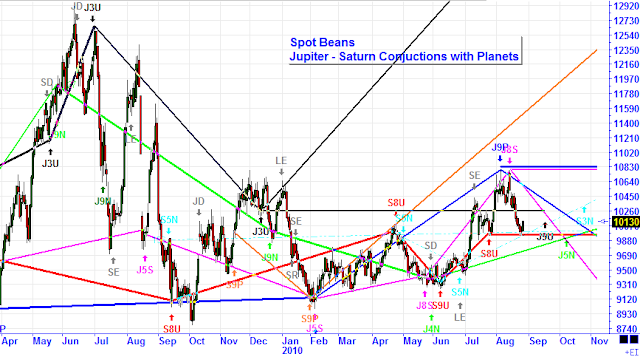Triangle breakout should cause new highs in beans. News is bullish and is now starting to show more below off the wire.
______________
COTLive.com -- Top Step Email Alert. For: __Soybeans_____________
Signup for Email Alerts at
http://www.cotlive.com
Sponsored by: Advantage Futures Inc.
http://www.advantagefuturesinc.com/TRADING IN COMMODITY FUTURES OR OPTIONS INVOLVES SUBSTANTIAL
RISK OF LOSS. PAST RESULTS ARE NOT NECESSARILY INDICATIVE OF FUTURE RESULTS.
SUDDEN DEATH SYNDROME HITS IOWA SOYBEAN CROP
>>
>> By Gary Wulf
>>
>> Of DOW JONES NEWSWIRES
>>
>> Most soybean fields in Iowa--a state normally ranked as one of
>> the nation's top-two producers of that important oilseed--are
>> currently under siege from Sudden Death Syndrome, a dramatically
>> named plant disease that often slashes harvest yields by 20% to 60%.
>>
>> "Over 50% of soybean fields are affected in Iowa, based on the
>> survey we did," said Iowa State University plant pathologist X.B.
>> Yang, widely considered one of the world's leading experts on
>> soybean disease. "Illinois, southern Minnesota, eastern Nebraska
>> [soybean fields] will be affected with less degree."
>>
>> Although SDS is caused by a soil fungus, [Fusarium virguliforme]
>> that infects soybean roots early in the growing season, symptoms
>> do not become apparent until July/August, first appearing as
>> yellowish spots on foliage. All infected leaves eventually wither
>> and die, killing the plant outright.
>>
>> "The worst infestations appear to be in central/eastern Iowa,
>> extending into northern/central Illinois. One observer near Peoria
>> said this was the first case of SDS that he had ever witnessed in
>> his vicinity," said Marion, Iowa-based market consultant Rich
>> Balvanz of AMS Commodities. "Unlike some years, when SDS is
>> limited to minor spots within a field, whole fields are being
>> affected by the condition, which results in premature death of
>> plants at the same time that pods are in the critical filling stage."
>>
>> Yang said in an interview Tuesday that 2010 is, "easily one of
>> the top 1 or 2 worst years for SDS since it was first discovered
>> in 1994. Some fields are toasted [completely dead]."
>>
>> Growers with fields infected by SDS have little recourse, apart
>> from rotating to a different crop, as no fungicides exist to
>> battle the disease and no soybean varieties exhibit complete
>> resistance to SDS. The disease is exacerbated by exceptionally
>> early plantings in wet soil, exactly the type of field conditions
>> which prevailed across the Midwestern grain belt this spring.
>>
>> "Losses vary from field to field ... depending at what
>> growth-stage the disease shows up and how large of an area is
>> affected," Yang said. "I have seen losses as high as 30 bushels
>> per acre. Generally severe premature defoliation can lead to 10 bushel losses."
>>
>> The U.S. Department of Agriculture last week predicted that Iowa
>> soybean farmers would harvest average yields of 51 bushels an
>> acre, equal to last year, and the second-highest for any state in
>> 2010, trailing only Nebraska. Total bean production in Iowa was
>> penciled in at nearly 518 million bushels, equaling 15% of the
>> entire U.S. crop of 3.43 billion bushels.
>>
>> Although national soy crop scores published Monday by the USDA
>> remained unchanged from a week previous, the amount of Iowa bean
>> acreage deemed worthy of classification as 'good' or 'excellent'
>> tumbled 4 percentage points, to 69%.
>>
>> "State-by-state [soybean yield] projections showed a decline of
>> about three-tenths of a bushel [in national soybean yields], with
>> significant set backs noted, due to too much rain in Iowa," said
>> Farm Futures analyst Bryce Knorr.
>>
>> Analysts feel any shortfall in Iowa yields may ultimately have
>> major consequences for the soybean market.
>>
>> "Iowa has experienced the worst case of sudden death in 16
>> years. In addition, the heat that engulfed much of the Midwest the
>> last few weeks may have taken the top-end yield off of what
>> appeared to be outstanding-looking beans," warned the
>> Stewart-Peterson Group. "The question now is whether or not the
>> yield can actually average 44 bushels," an acre nationwide, the
>> level of the USDA's latest U.S. soybean yield-forecast.
>>
>> Market analyst Mike Zuzolo of Global Comodity Analytics &
>> Consulting LLC, calculates that the loss of 150 million bushels in
>> U.S. soybean yield would induce a rise of "45 to 50 cents a bushel
>> in November CBOT futures, assuming the USDA's current 2010/11
>> soybean carryover forecast of 360 million bushels is correct.
>>
>> "But we know that the trade has already discounted that
>> ending-stocks forecast ... and is probably trading a carryover of
>> 225 million to 250 million bushels ... otherwise soybean [futures]
>> prices would be closer to $8, rather than $10.50," he said.
































